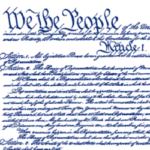This resource pairs the text of the U.S. Constitution with the Federalist Papers.
Reinventing American Democracy
The purpose of this lesson is to introduce students to the challenges facing American democracy and then spur a conversation around suggestions for revitalizing civic engagement and strengthening democratic values.
Congress and the Constitution
Use this information graphic to easily understand the House of Representatives and Senate and the articles and amendments in the Constitution.
Federalism
“Federalism” is the word used to describe the Constitution’s system of dividing political power between the national government and the states. What is federalism and how does it work? Why did the founders build federalism into our constitutional system and what are the modern debates over federalism today? Explore the National Constitution Center’s Federalism learning module to learn more!
Article VII: Ratification
After months of debate during the hot Philadelphia summer, on September 17, 1787, the Constitutional Convention finally adjourned and the new Constitution was signed, but it was not the law of the land yet. According to Article VII of the document, nine of 13 states would have to ratify (or approve) the new Constitution before it would officially replace the Articles of Confederation as our governing document.
The Constitution
This series of videos breaks down the different parts of the United States Constitution for students. In the videos, Kim and Sal interview constitutional scholars associated with the National Constitution Center, including Jeffrey Rosen, Heather Gerken, Ilya Somin, and Richard Garnett.
Constitution Clips
C-SPAN’s Constitution Clips makes the U.S. Constitution come alive by providing teachers and students with video clips from C-SPAN’s Video Library of the Constitution in action.
Constitution of the United States with Index and the Declaration of Independence, Pocket Edition

This is the 25th pocket edition of the complete text of two core documents of American democracy, the Constitution of the United States (with amendments) and the Declaration of Independence. The resolution calling for the ratification of Constitutional Convention is also included. A topical index to the Constitution is provided. (House Document 112-29, 2012)
Grade 3-5 Passing the Constitution, A Lesson in State Ratification
The purpose of this lesson is to introduce students to the ratification period that followed the Federal Constitutional Convention in Philadelphia. Through various activities to understand the what, why, who, where, and when of state ratification debates, students will see that state ratification of the Constitution was a critical element of establishing the new government’s legitimacy. Student activities throughout the day will help to build a State Ratification Bulletin Board.
Our Constitution
The Our Constitution book, written by Donald A. Ritchie and JusticeLearning.org, takes an in-depth look at the Constitution, annotated with detailed explanations of its terms and contents. Included are texts of primary source materials, sidebar material on each article and amendment, profiles of Supreme Court cases, and timelines. The complete book or individual chapters can be downloaded.
